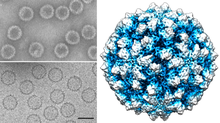Quadriviridae
| Quadrivirus | |
|---|---|

| |
| (Left) cryo-electron microscopy reconstruction of RnQV1 virions at 8Å resolution.
| |
| Virus classification | |
| (unranked): | Virus |
| Realm: | Riboviria |
| Kingdom: | Orthornavirae |
| Phylum: | Duplornaviricota |
| Class: | Chrymotiviricetes |
| Order: | Ghabrivirales |
| Family: | Quadriviridae |
| Genus: | Quadrivirus |
Quadriviridae is a family of
Structure

Mycoviruses in the family Quadriviridae have a non-enveloped isometric capsid which consists of 60 copies of heterodimers of the structural proteins P2 and P4. The diameter of the capsid is around 48 nm.[2][3]
Genome

Family member genomes are composed of double-stranded RNA. They are divided in to four segments which each code for a protein. The length of the different segments are between 3.5 and 5.0 kbp. The total genome is around 16.8 kbp. Inside the capsid with the genome there is also the RNA-dependent RNA polymerase.[2][3]
Life cycle
Quadriviruses are transmitted internally. They are propagated during cell division and hyphal anastomosis. Viral replication occurs in the cytoplasm. It follows the double-stranded RNA virus replication model. Double-stranded RNA virus transcription is the method of transcription. The fungi Rosellinia necatrix serves as a natural host.[2][3]
Taxonomy

The family Quadrivirdae has one genus Quadrivirus which contains the species:[4]
- Rosellinia necatrix quadrivirus 1
References
- PMID 30265238.
- ^ a b c d "ICTV Report Quadriviridae".
- ^ a b c d e "Viral Zone". ExPASy. Retrieved 13 August 2015.
- ^ "Virus Taxonomy: 2020 Release". International Committee on Taxonomy of Viruses (ICTV). March 2021. Retrieved 13 May 2021.
